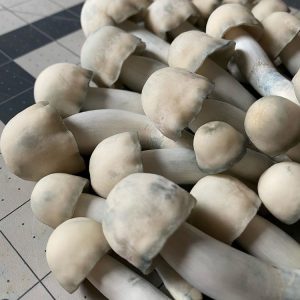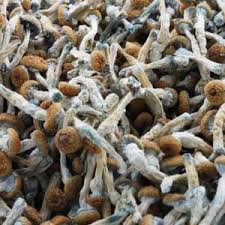What is psilocybin?
Psilocybin is produced synthetically or extracted from the psilocybe mexicana mushroom and other mushroom species. It is chemically related to LSD. The drug is most often sold in the mushrooms themselves and are known by names like “psychedelic mushrooms,” “magic mushrooms,” and “‘shrooms.”
How is psilocybin used?
Usually taken orally, psilocybin is found in dried or fresh mushrooms or as a powder in capsules. It is sometimes brewed into a tea. Typical doses range from 4 to 10 milligrams, but are hard to control because the active amount of hallucinogens in mushrooms differ widely according to the genus, strength, and condition (fresh or dried) of the mushrooms.
Why do people take psilocybin?
Mushrooms have been taken in religious rituals in indigenous cultures in Mexico and Central America for thousands of years. Recreational users today take them as a hallucinogen that is considered gentler and more natural (less chemical) than LSD. Users report feelings of mild euphoria and tingling physical sensations. They also report increased sensitivity to music and visual sensations.
Small doses (4 to 8 mg.) produce effects within half an hour which continue for 4 to 5 hours and may include mental and physical relaxation, tiredness, a sense of separateness from surroundings, feelings of physical heaviness or lightness, mood swings and perceptual distortions.
Are there short-term dangers of taking psilocybin?
Misidentification is one of the biggest dangers to taking psilocybin mushrooms. It is difficult to know if the mushrooms are psilocybin mushrooms because poisonous mushrooms also cause hallucinogenic effects. Signs that the mushrooms are toxic include stomach pains, vomiting and diarrhea. Poisonous mushrooms can even lead to death.
It is also difficult to determine what genus of mushroom you have and the dose of active hallucinogen each mushroom contains. To reduce the risk of a dangerous experience, it is safer to take a small amount and wait for its effects to be felt. In some cases, hallucinating can be unpleasant or even terrifying and the memory of this intense fear can remain with the person for life. A bad trip can occur at any dose. Signs of a bad trip include anxiety, confused or disordered thinking and panic.
At doses of 13 mg or more, users’ perceptions become altered, and they develop the same symptoms as an LSD user. They also might experience facial flushing, sweating, a slowed sense of time, and the sense that they are separate from their bodies. At these higher doses some of the warning signs of a potential overdose include:
- Lightheadedness or dizziness
- Numbness of the tongue, lips, or mouth
- Shivering or sweating
- Nausea
- Anxiety
Remember never to drive on psilocybin or any other hallucinogen. Operating machinery while under the influence of reality-altering substances is extremely dangerous.
Are there long-term consequences to taking psilocybin?
Some users experience such extremely unpleasant hallucinations that the fear of that experience remains with them for life. Users with a history of mental illness should not take hallucinogens, including psilocybin, because they can trigger or aggravate conditions like schizophrenia, mania, or depression.
Is psilocybin addictive?
Psilocybin does not produce compulsive drug-seeking behavior and addiction to hallucinogens is rare, although poly-drug addicts (people who are addicted to several drugs) frequently abuse hallucinogens as well. Tolerance to psilocybin mushrooms builds up rapidly and deters regular use.
Is there any way to reduce the risk of having a bad trip?
Experiences with hallucinogens are heavily influenced by environment. Here are some ways to reduce the risk of having a bad trip:
- Make sure you take it with someone you know and trust, preferably someone who knows how strong the effects can be.
- Make sure you are somewhere where you feel safe, secure and comfortable.
- Avoid taking hallucinogens if you are upset, feeling low or insecure–this could lead to a bad trip.
- Avoid taking more. The effects come on stronger after a while, and you could end up having a much stronger trip than you can handle.
- If you’re having a bad time avoid flashing lights and visuals, get a friend to take you to a safe, calm space.
How do I help a friend who’s having a bad trip?
It is important to make your friend feel safe and comfortable, usually away from other people, visual stimulation, and noises. Speak in a soothing voice to them and reassure them that their bad emotions, sensations, and visions are just the effects of the drug and will wear off in time. If your friend is inconsolable or seems violently agitated, seek medical help right away. Call EMS at 831.459.2231 or call 911.
How do I help a friend who’s having trouble with alcohol or drugs?
If you are concerned about a friend’s drug or alcohol use, this page contains information about different ways to help them.
Showing 1–16 of 21 results
-

ALBINO PENIS ENVY MAGIC MUSHROOM
$210.00 – $1,200.00 Select options -

Albino Penis Envy Mushroom
Read more -

GOLDEN TEACHER MUSHROOM
$220.00 – $1,300.00 Select options -

GOLDEN TEACHER MUSHROOM
$220.00 – $1,300.00 Select options -

Liberty Caps
Read more -

MAGIC MUSHROOM
$220.00 – $1,300.00 Select options -

MAGIC MUSHROOM CAPSULES
$5.00 – $150.00 Select options -

PENIS ENVY MAGIC MUSHROOM
$220.00 – $1,300.00 Select options -

PENIS ENVY MUSHROOM
$220.00 – $1,300.00 Select options -

Psilocybe azurescens
Read more -

Psilocybe baeocystis
$800.00 Select options -

Psilocybe cubensis
$180.00 – $1,100.00 Select options -

PSILOCYBE CUBENSIS
$210.00 – $1,300.00 Select options -

PSILOCYBE CUBENSIS MAGIC MUSHROOM
$210.00 – $1,300.00 Select options -

Psilocybe Cubensis Magic Mushroom
$200.00 – $1,300.00 Select options -

Psilocybe cyanescens
Read more
